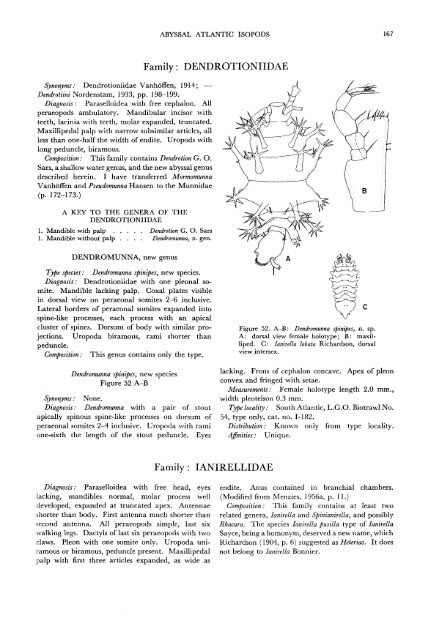The Isopods of Abyssal Depths in the Atlantic Ocean
The Isopods of Abyssal Depths in the Atlantic Ocean
The Isopods of Abyssal Depths in the Atlantic Ocean
You also want an ePaper? Increase the reach of your titles
YUMPU automatically turns print PDFs into web optimized ePapers that Google loves.
Synonyms: Dendrotioniidae Vanh<strong>of</strong>fen, 1914; —<br />
Dendroti<strong>in</strong>i Nordenstam, 1933, pp. 198-199.<br />
Diagnosis: Paraselloidea with free cephalon. All<br />
peraeopods ambulatory. Mandibular <strong>in</strong>cisor with<br />
teeth, lac<strong>in</strong>ia with teeth, molar expanded, truncated.<br />
Maxillipedal palp with narrow subsimilar articles, all<br />
less than one-half <strong>the</strong> width <strong>of</strong> endite. Uropods with<br />
long peduncle, biramous.<br />
Composition: This family conta<strong>in</strong>s Dendrotion G. O.<br />
Sars, a shallow water genus, and <strong>the</strong> new abyssal genus<br />
described here<strong>in</strong>. I have transferred Mormomunna<br />
Vanh<strong>of</strong>fen and Pseudomunna Hansen to <strong>the</strong> Munnidae<br />
(p. 172-173.)<br />
A KEY TO THE GENERA OF THE<br />
DENDROTIONIIDAE<br />
1. Mandible with palp<br />
1. Mandible without palp<br />
DENDROMUNNA, new genus<br />
ABYSSAL ATLANTIC ISOPODS 167<br />
Family: DENDROTIONIIDAE<br />
Dendrotion G. O. Sars<br />
Dendromunna, n. gen.<br />
Type species: Dendromunna sp<strong>in</strong>ipes, new species.<br />
Diagnosis: Dendrotioniidae with one pleonal somite.<br />
Mandible lack<strong>in</strong>g palp. Coxal plates visible<br />
<strong>in</strong> dorsal view on peraeonal somites 2-6 <strong>in</strong>clusive.<br />
Lateral borders <strong>of</strong> peraeonal somites expanded <strong>in</strong>to<br />
sp<strong>in</strong>e-like processes, each process with an apical<br />
cluster <strong>of</strong> sp<strong>in</strong>es. Dorsum <strong>of</strong> body with similar projections.<br />
Uropoda biramous, rami shorter than<br />
peduncle.<br />
Composition: This genus conta<strong>in</strong>s only <strong>the</strong> type.<br />
Dendromunna sp<strong>in</strong>ipes, new species<br />
Figure 52 A-B<br />
Synonyms: None.<br />
Diagnosis: Dendromunna with a pair <strong>of</strong> stout<br />
apically sp<strong>in</strong>ous sp<strong>in</strong>e-like processes on dorsum <strong>of</strong><br />
peraeonal somites 2-4 <strong>in</strong>clusive. Uropoda with rami<br />
one-sixth <strong>the</strong> length <strong>of</strong> <strong>the</strong> stout peduncle. Eyes<br />
Diagnosis: Paraselloidea with free head, eyes<br />
lack<strong>in</strong>g, mandibles normal, molar process well<br />
developed, expanded at truncated apex. Antennae<br />
shorter than body. First antenna much shorter than<br />
second antenna. All peraeopods simple, last six<br />
walk<strong>in</strong>g legs. Dactyls <strong>of</strong> last six peraeopods with two<br />
claws. Pleon with one somite only. Uropoda uniramous<br />
or biramous, peduncle present. Maxillipedal<br />
palp with first three articles expanded, as wide as<br />
Family: IANIRELLIDAE<br />
Figure 52. A-B: Dendromunna sp<strong>in</strong>ipes, n. sp.<br />
A: dorsal view female holotype; B: maxilliped.<br />
C: lanirella lobata Richardson, dorsal<br />
view <strong>in</strong>tersex.<br />
lack<strong>in</strong>g. Frons <strong>of</strong> cephalon concave. Apex <strong>of</strong> pleon<br />
convex and fr<strong>in</strong>ged with setae.<br />
Measurements: Female holotype length 2.0 mm.,<br />
width pleotelson 0.3 mm.<br />
Type locality: South <strong>Atlantic</strong>, L.G.O. Biotrawl No.<br />
54, type only, cat. no. 1-182.<br />
Distribution: Known only from type locality.<br />
Aff<strong>in</strong>ities: Unique.<br />
endite. Anus conta<strong>in</strong>ed <strong>in</strong> branchial chambers.<br />
(Modified from Menzies, 1956a, p. 11.)<br />
Composition: This family conta<strong>in</strong>s at least two<br />
related genera, lanirella and Sp<strong>in</strong>ianirella, and possibly<br />
Rhacura. <strong>The</strong> species lanirella pusilla type <strong>of</strong> lanirella<br />
Sayce, be<strong>in</strong>g a homonym, deserved a new name, which<br />
Richardson (1904, p. 6) suggested as Heterias. It does<br />
not belong to lanirella Bonnier.

















